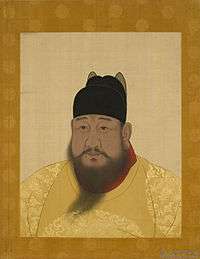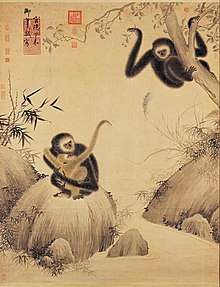Xuande Emperor
| Xuande Emperor 宣德帝 | |||||||||||||||||
|---|---|---|---|---|---|---|---|---|---|---|---|---|---|---|---|---|---|
 | |||||||||||||||||
| 5th Emperor of the Ming dynasty | |||||||||||||||||
| Reign | 27 June 1425 – 31 January 1435 | ||||||||||||||||
| Coronation | 27 June 1425 | ||||||||||||||||
| Predecessor | Hongxi Emperor | ||||||||||||||||
| Successor | Zhengtong Emperor | ||||||||||||||||
| Born |
16 March 1399 Beijing | ||||||||||||||||
| Died | 31 January 1435 (aged 35) | ||||||||||||||||
| Burial | Jingling, Ming tombs, Beijing | ||||||||||||||||
| |||||||||||||||||
| House | House of Zhu | ||||||||||||||||
| Father | Hongxi Emperor | ||||||||||||||||
| Mother | Empress Chengxiaozhao | ||||||||||||||||
| Xuande Emperor | |||||||||||||||||||||||
| Chinese | 宣德帝 | ||||||||||||||||||||||
|---|---|---|---|---|---|---|---|---|---|---|---|---|---|---|---|---|---|---|---|---|---|---|---|
| |||||||||||||||||||||||
_imperial_blue_and_white_vase%2C_from_The_Metropolitan_Museum_of_Art._%E6%98%8E%E5%AE%A3%E5%BE%B7_%E6%99%AF%E5%BE%B7%E9%8E%AE%E7%AA%AF%E9%9D%92%E8%8A%B1%E8%B2%AB%E8%80%B3%E7%93%B6%2C_%E7%BA%BD%E7%BA%A6%E5%A4%A7%E9%83%BD%E5%8D%9A%E7%89%A9%E9%A6%86_.jpg)
The Xuande Emperor (Chinese: 宣德帝; pinyin: Xuāndédì; 16 March 1399[1] – 31 January 1435), personal name Zhu Zhanji (朱瞻基), was the fifth emperor of the Ming dynasty of China, ruling from 1425 to 1435. His era name "Xuande" means "Proclamation of Virtue".
Life
Zhu Zhanji was the eldest son of the Hongxi Emperor and Empress Chengxiaozhao. He was described as a crown prince who was endowed with the quality of an excellent monarch in a section surrounded by superstition, of his biography. His grandfather, Yongle Emperor, had high hopes that he might play an important part to assist his father.[2]
He was fond of poetry and literature. Although he continued to refer to Beijing as the secondary capital on all official documents, he maintained it as his residence and continued to rule there in the style of his grandfather, the Yongle Emperor. He permitted Zheng He to lead the seventh and last of his maritime expeditions.
The Xuande Emperor's uncle, Zhu Gaoxu (the Prince of Han), had been a favorite of the Yongle Emperor for his military successes, but he disobeyed imperial instructions and in 1417 had been exiled to the small fief of Le'an in Shandong. When Zhu Gaoxu revolted, the Xuande Emperor took 20,000 soldiers and attacked him at Le'an. Zhu Gaoxu surrendered soon afterward, was reduced to the status of a commoner. Six hundred rebelling officials were executed, and 2,200 were banished. The emperor did not wish to execute his uncle at the start, but later events angered the emperor so much that Zhu Gaoxu was executed through fire torture. All his sons were executed as well. It is very likely that Zhu Gaoxu's arrogance, well detailed in many historic texts, offended the emperor. A theory states that when the emperor went to visit his uncle, Zhu Gaoxu intentionally tripped him.
In 1428, the Xuande Emperor granted King Hashi of Chūzan the family name Shang (尚, Shō in Japanese), gave him the title of Liuqiu Wang (琉球王, Jap: Ryūkyū-Ō, King of Ryūkyū), and gifted him a red lacquered tablet with Chung Shan (中山, Chūzan in Japanese) inscribed in gold, which was then placed on the Chūzonmon gate near Shuri Castle.[3]
The Xuande Emperor wanted to withdraw his troops from Việt Nam, but some of his advisors disagreed. After Ming garrisons suffered heavy casualties, the emperor sent Liu Sheng with an army. These were badly defeated by the Vietnamese. The Ming forces withdrew and the Xuande Emperor eventually recognized the independence of Việt Nam. In the north, the Xuande Emperor was inspecting the border with 3,000 cavalry troops in 1428 and was able to retaliate against a raid by the Mongols of the Northern Yuan dynasty. The Ming government let Arughtai's Eastern Mongols battle with Toghon's Oirat tribes of the west. The Ming imperial court received horses annually from Arughtai, but he was defeated by the Oirats in 1431 and was killed in 1434 when Toghon took over eastern Mongolia. The Ming government then maintained friendly relations with the Oirats. China's diplomatic relations with Japan improved in 1432. Relations with Korea were generally good with the exception of the Koreans resenting having to send virgins occasionally to the Xuande Emperor's imperial harem.
A privy council of eunuchs strengthened centralized power by controlling the Jinyiwei (secret police), and their influence continued to grow. In 1428, the notorious censor Liu Guan was sentenced to penal servitude and was replaced by the incorruptible Gu Zuo (d. 1446), who dismissed 43 members of the Beijing and Nanjing censorates for incompetence. Some censors were demoted, imprisoned, and banished, but none were executed. Replacements were put on probation as the censorate investigated the entire Ming administration including the military. The same year the emperor reformed the rules governing military conscription and the treatment of deserters. Yet the hereditary military continued to be inefficient and to suffer from poor morale. Huge inequalities in tax burdens had caused many farmers in some areas to leave their farms in the past forty years. In 1430, the Xuande Emperor ordered tax reductions on all imperial lands and sent out "touring pacifiers" to coordinate provincial administration, exercising civilian control over the military. They attempted to eliminate the irregularities and the corruption of the revenue collectors. The emperor often ordered retrials that allowed thousands of innocent people to be released.
The Xuande Emperor died of illness in 1435 after ruling for ten years. He ruled over a remarkably peaceful period with no significant external or internal problems. Later historians have considered his reign to be the height of the Ming dynasty's golden age.
The emperor as an artist

The Xuande Emperor was known as an accomplished painter, particularly skilled at painting animals. Some of his art work is preserved in the National Palace Museum, Taipei and Arthur M. Sackler Museum (a division of Harvard Art Museum) in Cambridge. Robert D. Mowry, the curator of Chinese art at the Arthur M. Sackler Museum, described him as "the only Ming emperor who displayed genuine artistic talent and interest."[4]
Also, the Xuande mark and period (1426-35) is often considered one of the most sophisticated periods in the history of Chinese Blue and White porcelain crafts. [5]
Family
- Parents:
- Zhu Gaochi (仁宗 朱高熾; 1378 – 1425)
- Empress Zhang (誠孝昭皇后 張氏; 1379 – 1442)
- Consorts and Issue:
- Empress Hu (恭讓章皇后 胡善祥; 1402 – 1443), personal name Shanxiang
- Princess Shunde (順德公主; 1420 – 1443)
- Princess Yongqing (永清公主; d. 1433)
- Empress Sun (孝恭章皇后 孫氏; 1399 – 1462)
- Princess Changde (常德公主; 1424 – 1470)
- Zhu Qizhen (英宗 朱祁鎮; 1427 – 1464)
- Empress dowager Wu (孝翼皇太后 吳氏; 1397 – 1462)
- Zhu Qiyu (代宗 朱祁鈺; 1428 – 1457)
- Third rank consort He (端靜貴妃 何氏; d. 1435)
- Fourth rank consort Zhao (純靜賢妃 趙氏; d. 1435)
- Fourth rank consort Wu (貞順惠妃 吳氏; d. 1435)
- Fourth rank consort Jiao (莊靜淑妃 焦氏; d. 1435)
- Fourth rank consort Cao (莊順敬妃 曹氏; d. 1435)
- Fourth rank consort Xu (貞惠順妃 徐氏; d. 1435)
- Fourth rank consort Yuan (恭定麗妃 袁氏; d. 1435)
- Fourth rank consort Zhu (貞靜恭妃 諸氏; d. 1435)
- Fourth rank consort Li (恭順充妃 李氏; d. 1435)
- Fourth rank consort He (肅僖成妃 何氏; d. 1435)
- Fourth rank consort Liu (淑妃 劉氏)
See also
References
- ↑ 《宣宗章皇帝實錄》. “仁宗昭皇帝嫡長子,母今太皇太后,以己卯歲二月九日生上於北京。” (in Chinese)
- ↑ History of Ming, Vol.9
- ↑ Kerr, George. Okinawa: History of an Island People. 1958, Tokyo, Charles E. Tuttle Company. Page 90.
- ↑ "Imperial Salukis: Speedy hounds, portrayed by a Chinese emperor". Harvard Magazine, May–June 2007.
- ↑ Yi Ching, Leung. "2016 Top 20 Chinese porcelain auctions (Sotheby's/ Christie's)". www.zentopia-culture.com/. Leung Yi Ching. Retrieved 15 January 2017.
| Wikimedia Commons has media related to Xuande Emperor. |
For details on the Xuande Emperor see The Cambridge History of China Vol 7, pages 285 to 304. This article is essentially a summary of those pages.
Further reading
| Wikimedia Commons has media related to: |
- "Early Ming China" by Edward Dreyer (1982).
- "Chinese Government in Ming Times" by Charles Hucker (1969).
Xuande Emperor Born: 25 February 1398 Died: 31 January 1435 | ||
| Regnal titles | ||
|---|---|---|
| Preceded by The Hongxi Emperor |
Emperor of China 1425–1435 |
Succeeded by The Zhengtong Emperor |